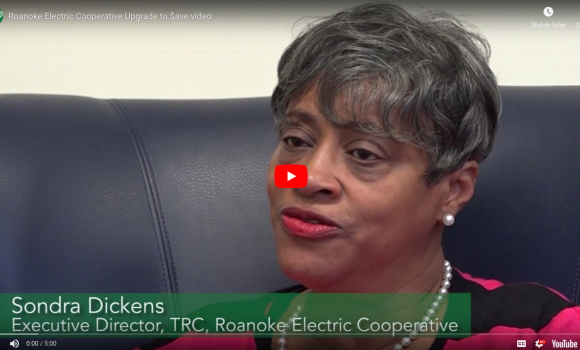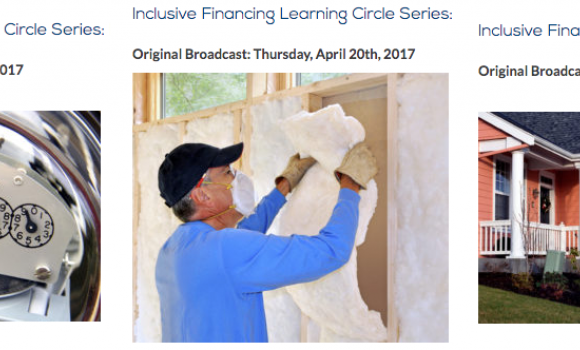
Inclusive financing programs are a real win-win-win that electric co-ops could do to better serve their members with cost-effective upgrades to members' homes paid for on their bill with no loan or upfront cost, millions in local economic development, increased customer satisfaction, and lowered peak electricity use. Rural electric cooperatives in Kansas, Kentucky, North Carolina, Tennessee, and Arkansas have implemented tariffed on-bill energy efficiency upgrade programs with great success investing tens of millions of dollars in energy efficiency and upgrading hundreds of homes, apartments, and businesses. Starting in 2019, electric co-ops are also using inclusive financing to increase access to solar energy: "...through Ouachita Electric’s HELP PAYS Program, members can finance up to 80% of the annual kilowatt hour savings generated by the solar system" from OECC's solar webpage.
Inclusive financing is a type of on-bill financing (OBF). OBF is a way to finance energy efficiency (and renewable energy) upgrades through a monthly charge on your energy bill. This reduces or eliminates the need for an upfront payment and high credit scores often needed for energy efficiency loan programs. Learn more from an overview by Appalachian Voices. Additional resources and case studies on OBF are available from the Environmental and Energy Study Institute (EESI). And Clean Energy Works has a wealth of knowledge on PAYS.
As of August 2019, there is a great overview of On-Bill Tariffed programs produced as an Issue Brief by the Department of Energy's Clean Energy for Low-Income Communities Accelerator (CELICA). And in late 2019 this article was authored by Clean Energy Works and published as part of the Behavior, Energy and Climate Change Conference including summary data from many PAYS programs. You can also find more information and links about on-bill tariffed financing below.
What characteristics would an ideal OBF program have? (via Appalachian Voices)
In general, the characteristics of an ideal on-bill financing program for home energy efficiency would include:
- a low interest rate, typically in the range of 0-5%
- sufficient financing to cover a comprehensive set of improvements and appliance upgrades, preferably up to $10,000 or more
- a repayment period of 10 to 15 years
- certified savings from efficiency improvements, with the savings equaling or exceeding the amount repaid by the customer on an annual basis
- repayment of the efficiency investment on the customer’s monthly utility bill
- the use of a customer’s bill payment history in lieu of a credit check when determining borrower eligibility
Pay As You Save: Inclusive On-Bill Financing or Debt-Free On-Bill Financing
Programs set up with a Pay As You Save voluntary tariff are connected to the electric meter (instead of being financed through a consumer loan) and paid back through on-bill financing. These inclusive financing programs are more accessible and generate a higher number of and larger investments in energy efficiency than loan programs.
- 2-page overview of how Inclusive Financing works
- 2-page handout about the benefits of inclusive financing with quotes and examples from existing programs.
- "Opening Opportunities with Inclusive Financing for Energy Efficiency: Report on the first year of the HELP PAYS Program at Ouachita Electric". This report provides a comparison between OECC's on-bill loan program and tariffed on-bill, or inclusive financing program, which had much greater uptake and impact:
- participation tripled, participants had immediate savings, renters could participate, average investment doubled, & total investment tripled!
- Chart comparing PAYS to on-bill loans and PACE from Clean Energy Works
- USDA Financing Options - including information about EECLP, RESP, and REDLEG.
More In-Depth Information/Resources for Utilities
- 2-page handout for Utilities from Liberty Homes
- 2019 article, also linked above, with summaries of data from many PAYS programs.
- Example of a Financial Analysis of tariffed on-bill financing from Minnesota (PDF is in the left column also)
- Utility Guide to Tariffed On-Bill Programs by Southeast Energy Efficiency Alliance
Examples of PAYS® Programs at Electric Co-ops
- How$martKY (Kentucky)
- Roanoke Electric (North Carolina)
- Midwest Energy's How$mart (Kansas)
- Ouachita Electric Cooperative (Arkansas)
- Appalachian Electric's U $ave Advantage Program


